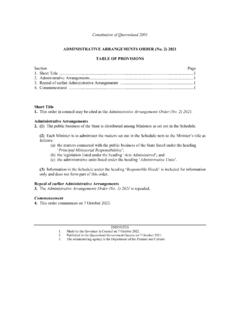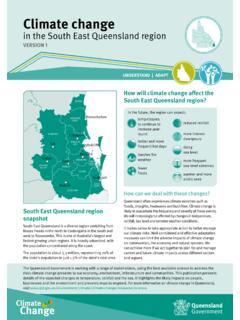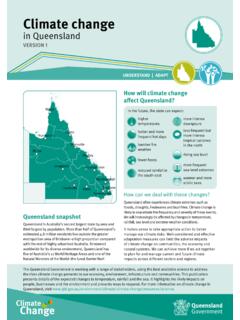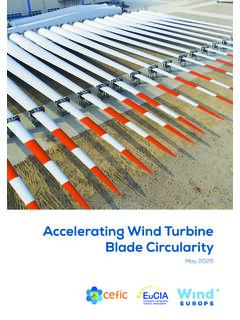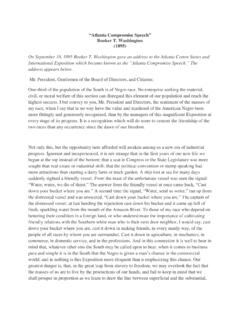Transcription of Technical Note - Roofs - Queensland
1 Great state. Great of Environment and Heritage ProtectionTECHNICAL NOTEC onserving Roofs - 2 -Prepared by: Heritage Branch, Department of Environment and Heritage Protection State of Queensland , 2014 The Queensland Government supports and encourages the dissemination and exchange of its information. The copyright in this publication is licensed under a Creative Commons Attribution Australia (CC BY) this licence you are free, without having to seek our permission, to use this publication in accordance with the licence must keep intact the copyright notice and attribute the State of Queensland as the source of the more information on this licence, visit publication was produced in accordance with resource-sharing arrangements approved by the Australian Heritage Information Network. Some material and concepts have been adapted from the Heritage Information Series published by the NSW Heritage Office, online edition document has been prepared with all due diligence and care, based on the best available information at the time of publication.
2 The department holds no responsibility for any errors or omissions within this document. Any decisions made by other parties based on this document are solely the responsibility of those parties. If you need to access this document in a language other than English, please call the Translating and Interpreting Service (TIS National) on 131 450 and ask them to telephone Library Services on +61 7 3170 publication can be made available in an alternative format ( large print or audiotape) on request for people with vision impairment; phone +61 7 3170 5470 or email more information about Queensland heritage matters visit March 2014 Version #30250 This Technical note is provided as general, best practice advice for conserving places of heritage value. It is not exhaustive and is not to be taken to legitimise works carried out without the necessary approvals.
3 For information about work that may be done without application, refer to General Exemption Certificate: Queensland Heritage Places, available on the EHP website at 3 -ContentsIntroduction conserving Roofs ..5 Purpose ..5 Context ..51. Metal Roofs ..7 Purpose ..7 Prolonging the life of a metal roof ..7 Corrugated galvanised iron ..7 Repairing corrugated galvanised Roofs ..8 Materials compatibility and appropriateness ..9 Sheet lengths ..9 Colour ..9 Fastenings ..9 Decorative and other features ..10 Other galvanised steel profiles ..10 Non-ferrous metal roofing ..11 Repairing non-ferrous metal roofing materials ..112. Asbestos cement Roofs ..12 Purpose ..12 Context ..12 Historical introduction of asbestos cement roofing ..12 Identifying asbestos cement roofing ..13 Maintaining an asbestos cement roof ..13 Repairing and replacing asbestos cement Roofs .
4 13 Painting ..133. Terracotta tiles, slate and shingle roofing ..14 Purpose ..14 Terracotta roof tiles ..14 Slate roofing ..16 Shingle Roofs ..174. Roof drainage ..18 Purpose ..18 Context ..18 Materials, profiles and size ..19 Maintenance ..20 Repair of gutters and downpipes ..21- 4 -5. Roof structures ..22 Purpose ..22 Context ..22 Roof form and framing ..22 Joints and fastenings ..24 Common defects in roof structures ..26 Repairs and alterations to roof structures ..276. Roof installations ..28 Purpose ..28 Context ..28 Guiding principles ..28 Further reading ..31 Great state. Great state. Great of Environment and Heritage Protection Technical NoteINTRODUCTION CONSERVING ROOFSP urposeThis series of Technical notes is designed to help owners and managers of heritage-listed buildings understand the characteristics of their particular building in relation to the care, and where necessary the repair, of its word roof is used in two different senses; the supporting structure that spans the building and holds up the protective covering, and the protective covering material.
5 These notes describe, individually, the types of roof coverings found on heritage-listed buildings in Queensland and outline conservation issues associated with them in the following sections:1. Metal Roofs deals mainly with corrugated galvanised iron and steel but also includes copper, zinc and lead Asbestos cement Roofs considers the problems posed by asbestos in the context of heritage-listed Terracotta tiles, slates and need for a supporting structure and the means of rainwater disposal is common to all roof coverings. The individual characteristics of the coverings determine, to some extent, the detail of the rainwater goods and the type of structure required to support the roof. Conservation issues associated with disposing of rainwater and supporting various installations on the roof are discussed in the following sections:4.
6 Roof drainage common to all Roof structure timber, steel or a combination of these materials make up the roof structure of most heritage-listed Roof installations aerials, satellite dishes, air conditioning units, solar panels, safety systems roof may be considered to be the most important part of the building. Even without walls, a roof can be used as a shade structure or to provide protection for produce, materials or equipment. It excludes sun, wind and rain, and protects and preserves the materials that comprise the lower parts of the the early days of the European settlement, Roofs were first covered with bark, and later with shingles split from trees such as Forest Oak (casuarina torulosa) and Ironbark (eucalyptus fibrosa). Shingles required a steep pitch. They were widely used, however their lifespan was comparatively short and few shingle Roofs have survived intact today.
7 Shingles were often simply sheeted over with corrugated iron when this material became available. The tradition of relatively steep pitched Roofs was continued well into the 20th century when new materials made lower pitches more roof of the Victorian house often drew attention to itself with varied forms, steep pitches, gables and decoration- 6 -In the Queensland climate, the need to quickly dispose of rainwater and give shade has given rise to Roofs of strong visual character. The profiles of the roof ridges against the sky and spreading, lower-pitched verandah Roofs are significant architectural features that must be handled with care when carrying out conservation works. These 19th and early 20th century roof forms were often celebrated with decorative elements such as cast iron cresting on ridgelines and turned finials at gable ends.
8 Functional installations like ventilators were similarly decorated to take advantage of their location at high points of the galvanised iron or steel sheets are the most common form of roof covering found in Queensland . It is comparatively light, easy to transport and requires only basic framing for support. It provides a good surface for collecting water, an important consideration in as common as corrugated iron, but characteristic of many suburbs in Australia, is the orange-red colour of terracotta roof tiles. The Marseilles pattern tile, introduced first in 1886, was most popular during the Federation period and is still being less common than tiles in Queensland are natural slate Roofs . Slates were imported from England and Wales and, being an expensive option, were only used on prestigious buildings. Asbestos cement first made its appearance in Australia as an imported roofing slate early in the 20th century.
9 These slates were being produced locally by the 1920s. The greatest use of asbestos cement came in the post war years 1945 to 1970 in the form of the super six roofing sheet, marketed as a low cost, fire-proof, durable material. Some heritage-listed buildings, both domestic and commercial, still have asbestos cement Roofs . Although asbestos-containing products are now banned, existing Roofs are not hazardous unless damaged or decaying. Removing or treating asbestos products may only be undertaken by licensed have, over the years, become the home of a variety of installations deemed necessary for everyday life and which the structure was not designed to support. These installations range from air conditioning plant to photovoltaic panels. Apart from their likely negative affect on the appearance of the place, and hence its heritage significance, there are concerns for structural adequacy and the likelihood that the installation will be a source of leaks.
10 Work carried out on the roof must be done safely. On high or complex Roofs , this may require installing safe access routes or at least fall arrest and restraint systems. When it becomes necessary to replace or carry out extensive work on the roof covering it may be appropriate to consider installing insulation and sarking. Sarking adds a second line of defence against roof leaks and insulation will improve the thermal efficiency of the building. Care must be taken to ensure that problems such as condensation are not created in vulnerable spaces by the installation of insulation and state. Great state. Great of Environment and Heritage Protection Technical Note1. METAL ROOFSP urposeThis section describes the characteristics and conservation issues related mainly to corrugated galvanised iron and steel roof coverings. Other sheet metal coverings are dealt with, but in less detail.




